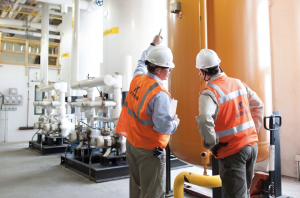What is maintenance management?
Maintenance management is the process of maintaining a company’s assets and resources. The purpose is to ensure that production proceeds efficiently and that resources are used effectively.
Maintenance management is one of those aspects of managing a company that is usually not explored in depth. People outside of the maintenance industry may not realize how much time and effort go into making the flow of products through supply chains to the general world. Let’s go in-depth on these important processes and understand why they are important.

What is maintenance management?
Maintenance management involves keeping track of assets and parts. The purpose is to ensure that production proceeds efficiently and the minimum amount of resources are wasted. This is generally accomplished by a tailored combination of software, practices, and personnel that focus on achieving these goals.
Objectives of maintenance management
Almost any business process has objectives and maintenance management is no different. The five main objectives are:
- Budgeting
- Scheduling work
- Regulation compliance
- Optimizing work
- Improving safety
Budgeting
Maintenance managers usually work with a limited budget and they might have many different items that need that budget. When there is greater budget transparency, there is greater potential to leverage the funds available.
Scheduling work
Scheduling employees and personnel is always a delicate balancing act. When equipment is not maintained, the company schedule can be quickly thrown off balance. This objective impacts many more aspects of the company than just maintenance management.
Regulation compliance
It’s easy to lose track of all the regulations that you must keep track of in your company. However, most of these regulations don’t change often and can be tracked fairly easily. Quality maintenance management teams and software keep the needed information to comply with regulations at your fingertips.
Optimizing work
Well-maintained equipment optimizes all the workflows involving equipment. In turn, this optimizes employee efficiency and company productivity. In ideal circumstances, this creates a loop of optimization and efficiency that serves the entire company.
Improving safety
Finally, safety levels increase when maintenance is properly managed. Equipment breaks down less often, locations are better maintained, and the small risks, such as improperly cleaned floors and shelves, are dealt with in a timely way.
3 Maintenance Management Examples
An example of maintenance in progress.
What are the results when maintenance has been neglected and when it’s been properly performed? Let's take a look at examples of maintenance management practices and their results.
1. Simmons Feed Ingredients
The Simmons Feed Ingredients company’s first lubrication program worked reasonably well. However, when they tried to switch the oil blend used, the company was left scrambling to catch up.
It took maintenance over three-quarters of a day to get the plant back up and running as a result of this poor decision. This cost the company a large amount of time and resources to fix, including hiring an outside consultant to make the necessary evaluations to get them back on track.
2. McDonald's
McDonald’s is well known for the sheer amount of people that they serve on a day to day basis. Many of those people are served by locations that are owned by individuals as part of the larger franchise. One particular location has dramatically improved their speed and productivity by using UpKeep software.
This McDonald’s has brought equipment downtime to the lowest it can be due to their quality maintenance management practices.
3. Marriott Hotels
Marriott hotels take pride in their seamless customer experience. Their old paper system at one location in Cincinnati, Ohio was simply not rising to the challenge. When they switched to UpKeep, the director of engineering operations described the process “as smooth as one heartbeat to another.”
The team quickly learned how to use the UpKeep mobile application. Now, the company’s day-to-day maintenance processes are smooth and transparent.
Types of maintenance management
Not all maintenance management is the same. However, it’s not necessarily the most intuitive either. Here are some of the different types of maintenance management and their roles for businesses.
Time-based
Time-based maintenance is an umbrella term used to describe all maintenance that is based on the calendar. Examples would include daily, weekly, monthly, and more tasks that need to be done at the same time, every time.
Predictive
Predictive maintenance is a type of condition-based maintenance that specifically monitors asset conditions using sensors. These sensors send data to a central database so that users can see what is happening as it’s happening in real-time.
Condition-based
Similar to time-based maintenance, condition-based maintenance is another wide category of general maintenance management. It is defined by the use of sensor devices on company assets and equipment.
Run to failure
Perhaps the simplest type of maintenance management, (run to failure maintenance) is reaction-based. When an asset breaks, this maintenance is performed to get it back up and running again.
Benefits of maintenance management
Before we get into the specifics of what the benefits of maintenance management are, it’s worth pointing out that many of these are positive results to the general objectives of maintenance management. That’s not a coincidence; when the objectives are reached, these benefits flow over the entire company in question.
Cost savings
Measuring and analyzing your assets on a regular basis also enables you to see where improvements will need to be made. These costs can be calculated well in advance of the need, enabling the company to find the best price for new and/or improved assets.
Improve workplace safety
Properly maintenance equipment and well-kept facilities prevent more employee accidents than most other business safety measures. This is particularly true on a day to day basis.
Enhance productivity
When workplaces are safer, employees don’t have to worry about as many daily risks, particularly risks due to equipment. This has a direct impact on overall productivity.
Minimizes human error
A well-maintained facility also decreases the chances of human error. This is particularly true when aspects of maintenance become automated.
Uncovers maintenance trends
Finally, a quality maintenance management system uncovers what exactly is going on on a day-to-day basis. If an asset, a piece of infrastructure, or other key part of your company’s operation is consistently underperforming, you will find the fault much faster.
Key Takeaways
What should we take away from this?
- Maintenance management is the process of maintaining the company’s -assets and resources.
- Its main objective is to streamline company processes and protect assets
- Examples abound both of maintenance management done correctly and incorrectly.
- There are multiple types of maintenance management
- Maintenance management solutions are worth the initial investment and time that they take to set up in order for your company to reach its full potential.
Maintenance FAQ
What is the scope of maintenance management?
The scope of maintenance management covers all aspects of maintenance in all areas that need maintaining.
What are techniques of maintenance management?
These vary by need and company using them, but some basic techniques of maintenance management include optimizing for efficiency, protecting assets, and streamlining overall processes.
Why is maintenance management important?
Maintenance management is important because it protects the company’s assets in a real, tangible way.
Want to keep reading?
Types of Maintenance
Compare Different Types of Maintenance
What Is Planned Maintenance? | 6 Benefits & Workflow
4,000+ COMPANIES RELY ON ASSET OPERATIONS MANAGEMENT
Leading the Way to a Better Future for Maintenance and Reliability
Your asset and equipment data doesn't belong in a silo. UpKeep makes it simple to see where everything stands, all in one place. That means less guesswork and more time to focus on what matters.

![[Review Badge] Gartner Peer Insights (Dark)](https://www.datocms-assets.com/38028/1673900494-gartner-logo-dark.png?auto=compress&fm=webp&w=336)

